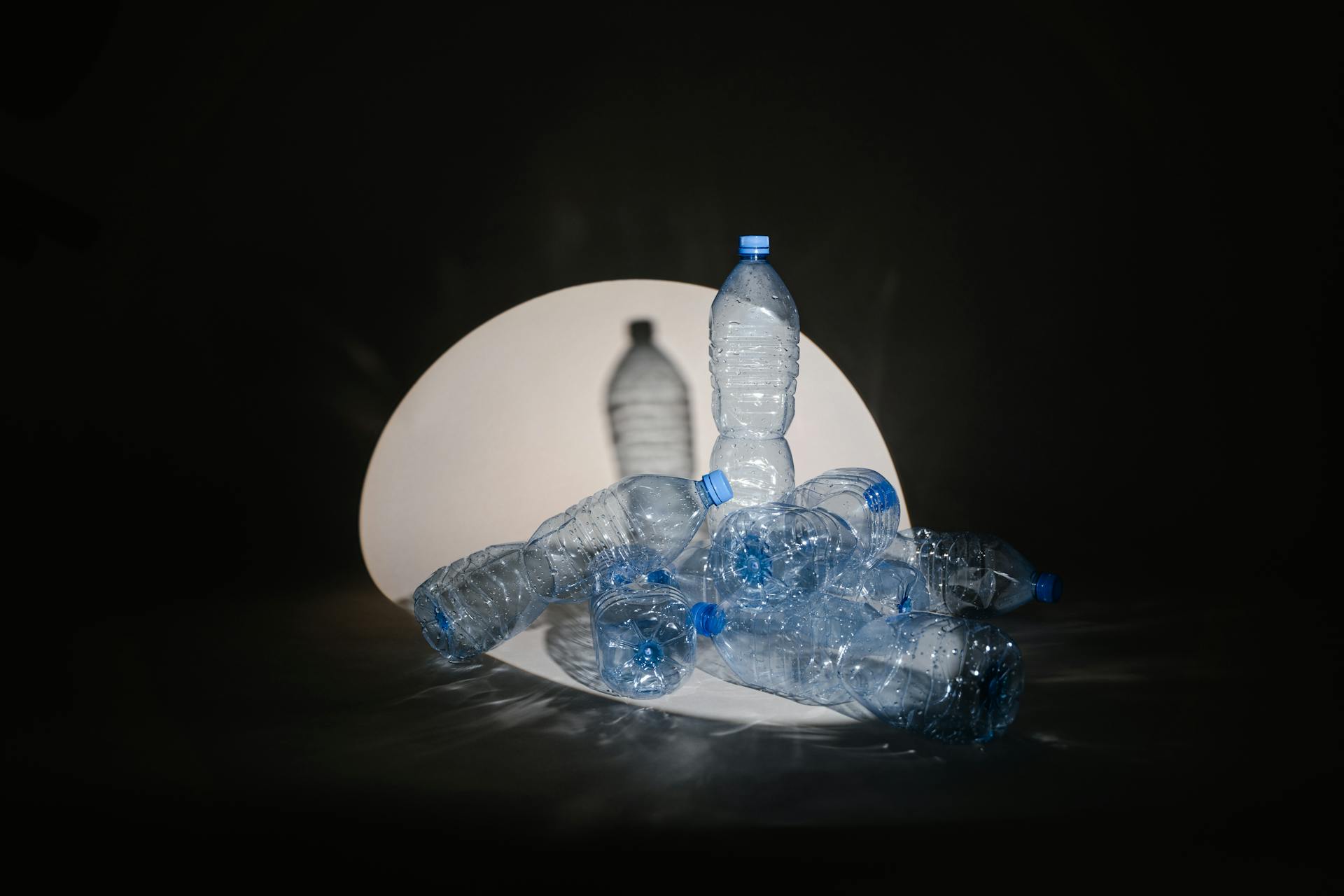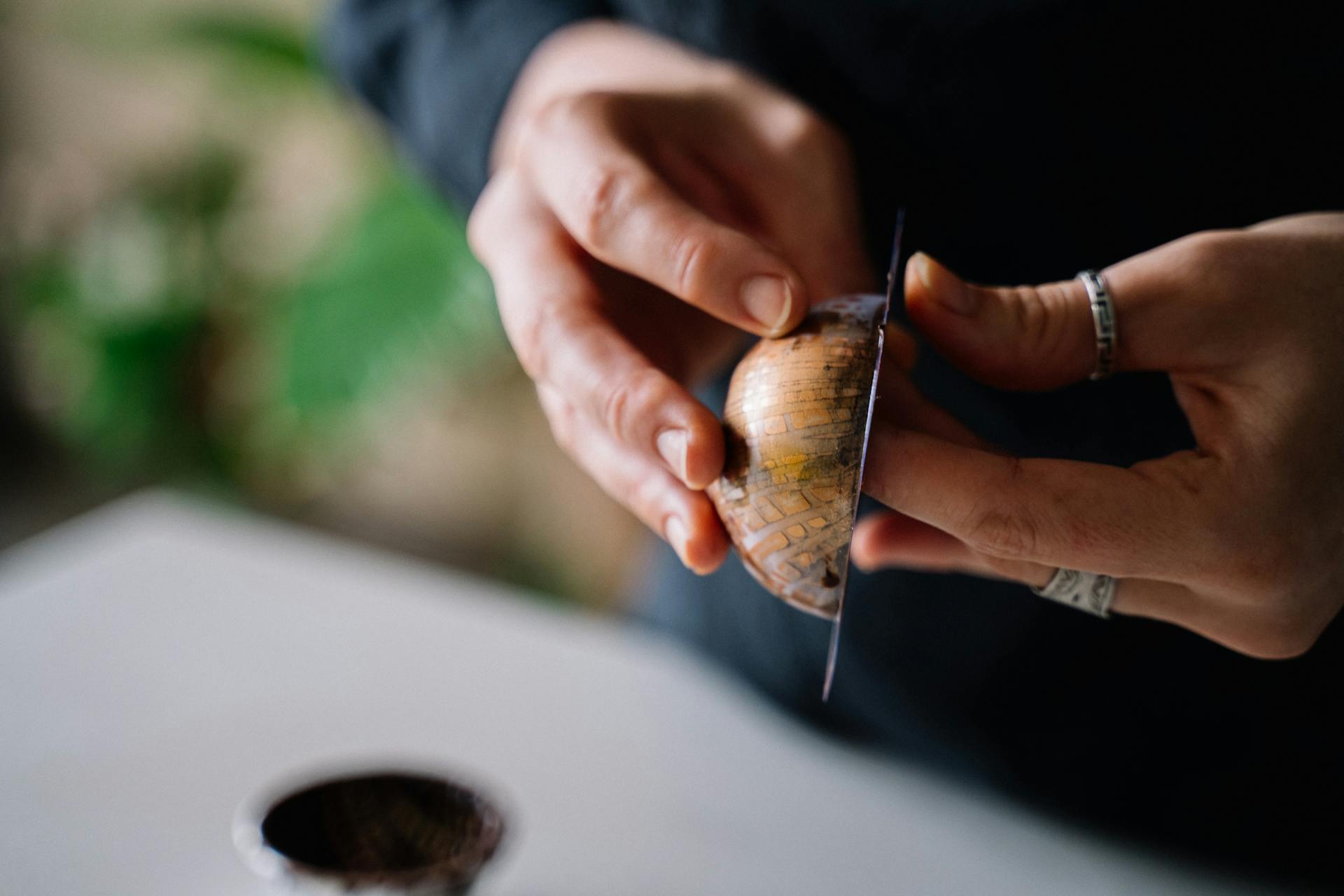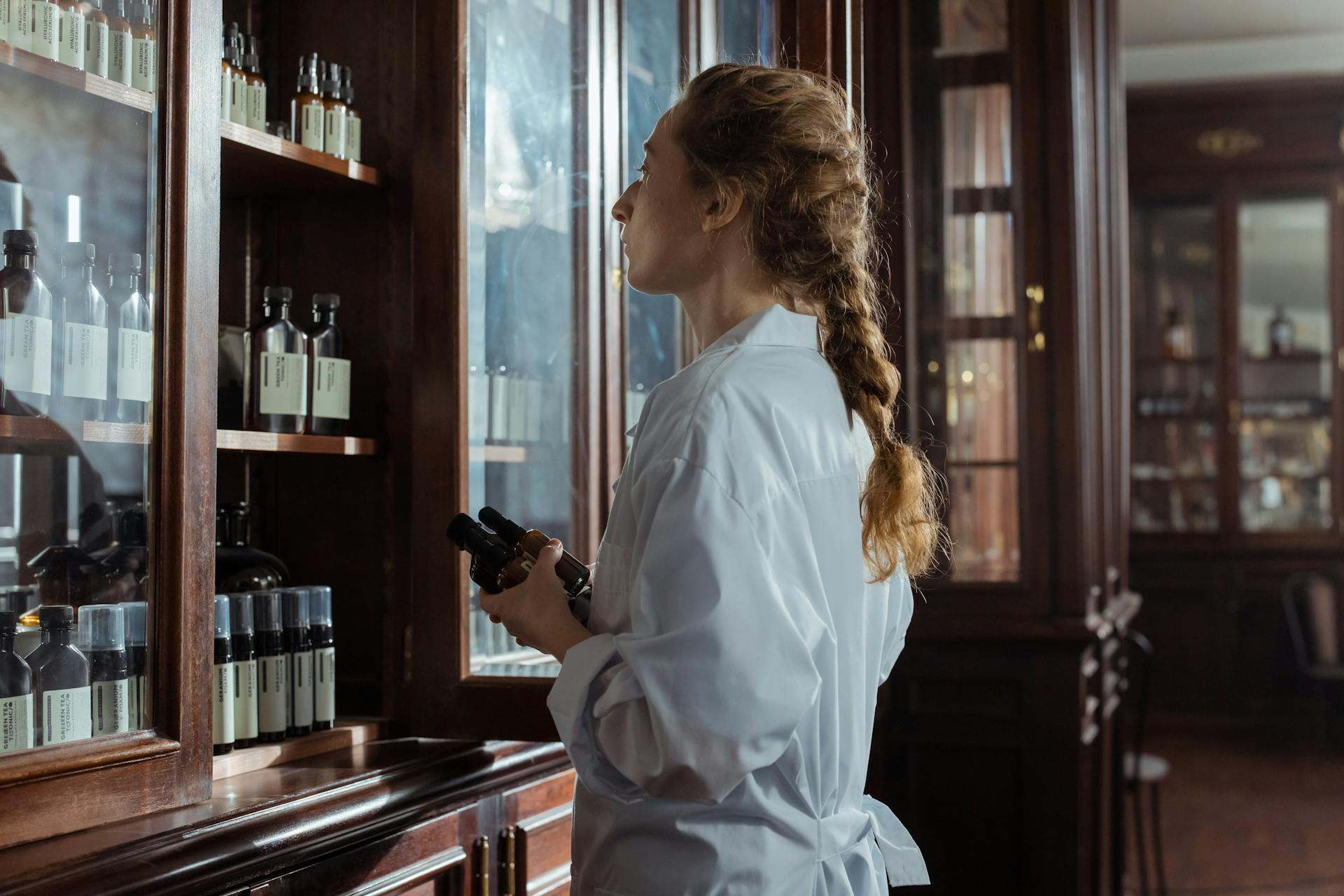
PP and PET plastics may seem like interchangeable terms, but they have distinct differences in their composition and uses. PP stands for Polypropylene, a thermoplastic polymer that's commonly used in packaging, textiles, and automotive parts.
PP is known for its lightweight and flexible properties, making it ideal for producing bottles, containers, and other disposable items. PET, on the other hand, is a type of polyester that's often used for water bottles and other containers that require high clarity and durability.
Both PP and PET plastics are widely used due to their affordability and versatility. However, they have different melting points, with PP having a lower melting point than PET. This difference affects how they're processed and used in various applications.
In terms of recyclability, both PP and PET plastics can be recycled, but they require separate processing due to their distinct chemical properties.
Discover more: Air Canada Pet Cargo
What Is Plastic?
Plastic is a broad term, but did you know that it's actually a group of synthetic or semi-synthetic materials that can be molded or shaped into various forms?
PET plastic, also known as Polyethylene Terephthalate, is a type of plastic that's formed by combining terephthalic acid and ethylene glycol through a process called polycondensation.
PET plastic is known for its high transparency, making it a popular choice for packaging and other applications.
It's also extremely tough and resistant to heat, with excellent chemical resistance and barrier properties.
As Plastic #1, PET can be used to make bottles, films, sheets, and fibers, which is why it's widely used in the packaging industry.
PET plastic is used in a variety of fields, including electronics, medical and healthcare, construction, and the automotive industry.
Physical Properties and Chemical Properties
Polypropylene (PP) exhibits excellent rigidity and resistance to flex fatigue, with hinges made from PP able to withstand more than 70 million cycles of folding without breaking. It's also relatively lightweight, with a density of 0.90-0.91g/cm³.
PET, on the other hand, has minimal wear and high hardness, making it ideal for applications requiring materials with exceptional tensile strength and transparency. Its melting point is around 250°C/482°F, providing stability under high temperature conditions.
PP has good heat resistance, with a continuous use temperature of 110-120°C, and excellent electrical insulation properties, maintaining good electrical insulation even in humid environments. PET also has good electrical insulation properties, with little impact from temperature changes.
Here's a comparison of the physical and chemical properties of PP and PET:
What Is Polyethylene?
Polyethylene (PET) is a polymer with remarkable mechanical qualities, including strong tensile strength and impact resistance.
It's born from the polymerization of ethylene glycol and terephthalic acid, making it perfect for a variety of applications. PET is a chemical-resistant champion, making it the top choice for holding carbonated drinks without any nasty side effects, even over extended periods.
Its transparent appearance makes it perfect for bottles, allowing you to see the contents clearly and ensuring safety. Plus, the polyester fabrics you love? Yup, those are made of PET.
PET is renowned for its outstanding clarity, making it the go-to choice when content visibility is paramount, such as in clear water or soda bottles.
Chemical Properties

PP is very chemically stable, except for being eroded by concentrated sulfuric acid and nitric acid, it does not react with most chemicals.
However, certain halogenated compounds, aromatics, and high boiling point hydrocarbons can cause it to swell.
PET material is resistant to weak acids and organic solvents but not to hot water soaking or alkalis.
PP has good chemical stability and does not react with most chemicals except strong oxidizers.
PET decomposes under the action of strong acids, strong bases, and steam, but is resistant to oil, fats, dilute acids, dilute alkalis, and most solvents.
Here's a comparison of the chemical properties of PP and PET:
Barrier Properties
PET is the choice for applications requiring barriers against gases and moisture like food and beverage packaging that needs to maintain freshness and shield against external contaminants. This is because PET has excellent barrier properties that help perishable items have a shelf life.
Polypropylene (PP) is ideal for applications where moisture resistance outweighs the need for gas barriers like in bags and certain types of containers. PP provides a gas barrier, but it is less effective against moisture compared to PET.
PET's barrier properties are crucial for maintaining the freshness of food and beverages, making it a popular choice for packaging.
Suggestion: Food Service Plastic Wrap
Pros and Cons
When choosing between PP and PET plastic, it's essential to consider their pros and cons. Here are some key advantages and disadvantages of each material.
PP plastic is valued for its lightweight properties, making it suitable for food packaging and medical applications. Its excellent heat and chemical resistance also make it a popular choice. However, its susceptibility to weathering and lack of rigidity can limit its use in outdoor or structural applications.
One of the main advantages of PP material is its excellent mechanical properties, which make it ideal for various applications. It also boasts high heat resistance, chemical stability, and electrical insulation.
However, PP plastic has some significant drawbacks. It easily ages, and its poor cold resistance can be a concern. Additionally, it has poor colorability, which can be a limitation in certain applications.
In contrast, PET plastic is known for its high transparency and strong barrier properties, making it ideal for transparent packaging and preserving the quality of consumables. It also boasts high mechanical strength and is recyclable.
However, PET plastic has some notable disadvantages. It has poor corona resistance and is not resistant to hot water immersion or alkalis.
Here's a comparison of the pros and cons of PP and PET plastic:
Ultimately, the choice between PP and PET plastic will depend on the specific requirements of your application. By considering the pros and cons of each material, you can make an informed decision and choose the best material for your needs.
Health Safety Concerns
PP and PET plastics are widely used in our daily lives, but their safety is a growing concern. PP is generally considered a safe plastic material, being odorless, tasteless, and non-toxic.
Under normal usage conditions, PP does not leach harmful substances into food or beverages, making it a popular choice for food containers and kitchen utensils. This means you can use PP products without worrying about your food being contaminated.
PET material is safe at room temperature, but it may leach harmful substances like DEHP when exposed to high temperatures, used for a prolonged period, or when containing overheated liquids. This is a good reminder to handle PET products with care, especially when heating liquids in them.
Discover more: Plastic Wrap for Food
Health Safety Concerns
PP is generally considered a safe plastic material, being odorless, tasteless, and non-toxic.
Under normal usage conditions, polypropylene does not leach harmful substances into food or beverages, making it a popular choice for food containers, baby bottles, and kitchen utensils.
PET is safe at room temperature, with its transparency and stability making it an ideal choice for beverage bottles and other packaging materials.
However, PET bottles may leach harmful substances like DEHP when exposed to high temperatures, used for a prolonged period, or when containing overheated liquids.
PP is notably heat-resistant and the only plastic recommended for microwave heating, making it a convenient option for reheating food.
Caution should be exercised regarding the usage conditions and duration when utilizing plastic products, especially PET bottles, to avoid any potential health risks.
Safer Plastic Options
PP and PET plastics have undergone rigorous monitoring and testing to meet food safety standards, making them reliable choices in terms of safety and non-toxicity.
Both PP and PET are non-toxic and odorless, with PP also boasting good thermal stability, mechanical properties, and corrosion resistance.
Their production processes adhere to environmental principles, minimizing their impact on the environment.
PP is highly recyclable, making it a relatively environmentally friendly material.
Under normal temperature and pressure, PP remains stable and does not easily decompose into harmful substances.
PET plastic has excellent transparency, chemical resistance, and mechanical strength, effectively protecting food from external influences.
Both PP and PET are commonly used for food containers, medical supplies, and household items due to their reliable safety and non-toxicity.
Their production processes minimize environmental impact, making them safer plastic options.
Applications and Uses
PP plastic is widely used in the production of woven products like plastic bags, tarpaulins, and ropes.
PP injection-molded products are used in small household appliances, daily necessities, toys, washing machines, automobiles, and turnover boxes.
PP pipes are ideal for buildings, agriculture, and chemical piping systems due to their high-temperature resistance, easy pipe connection, and recyclability.
PP fibers are used in decoration, industry, and apparel sectors, such as clothing and carpets.
PET plastic is mainly used for bottle-grade polyester, which is widely used for packaging various beverages, especially carbonated drinks.
PET is also used for polyester film, primarily for packaging materials, films, and tapes.
PET fibers are used for textiles, and glass fiber-reinforced PET is suitable for the electronics, electrical, and automotive industries.
PP is commonly used to produce food and pharmaceutical containers and packaging.
PP injection-molded products dominate the consumer market, used in automotive parts, electrical components, furniture, and medical equipment.
The packaging sector is the largest application market for PET plastics, including bottles, films, and more.
PET is also used for electrical components, industrial bearings, and automotive distribution panels.
PET is used to manufacture polyester staple fibers and filament yarns, serving as raw material for polyester fiber companies to process fibers and related products.
Choosing Between Plastics
PET material is more robust and durable than PP material, making it suitable for products like bottles and jars.
For products that require transparency, like packaging or containers, PET is the better choice due to its higher transparency.
PP is softer and lighter than PET, making it ideal for soft and lightweight products like bags and clothing.
Both PET and PP plastics can be melted and reshaped multiple times, making them highly adaptable to manufacturing techniques.
They find applications across industries such as consumer goods, packaging, and textiles.
Both materials offer chemical resistance, although PET is more prone to recycling than PP.
In the end, the decision between PET and PP depends on your specific application requirements.
Comparison and Differences
PET and PP plastics have some key differences. PET is a milky white or pale yellow, highly crystalline polymer with high transparency and toughness, while PP is a lightweight polymer with high strength and heat resistance.
In terms of density, PET has a density of 1.30-1.33 g/cm³, whereas PP has a density of 0.89-0.91 g/cm³. This makes PP the lighter of the two.
PET has a melting point of 250-255 ℃, while PP has a melting point of 164-170 ℃. This affects their processing properties, with PP having a faster crystallization rate and lower molding shrinkage rate.
Here's a comparison of their physical properties:
These differences affect their applications and uses. PET is often used in packaging and textiles, while PP is used in consumer goods and other industries.
Recyclability and Costs
PP plastic is generally more recyclable than PET plastic, with a higher percentage of PP plastic being recycled in the US.
PET plastic, on the other hand, is often contaminated with food residue, which makes it difficult to recycle.
The cost of recycling PP plastic is also lower than PET plastic, due to its simpler manufacturing process.
The Recyclability of
The Recyclability of PP and PET plastics is a game-changer for reducing environmental pollution. Both PP and PET plastics are recyclable materials.
PP plastic is highly recyclable due to its stable chemical properties and high heat resistance. This allows it to maintain its physical and chemical stability through multiple recycling processes.
PP products, such as packaging materials and turnover boxes, can be repeatedly recycled by heating, melting, and reshaping, without losing their original physical properties. This makes PP plastic a valuable resource for recycling.
PET plastic, especially food-grade PET (such as food packaging bottles), is also recyclable. During the recycling process, PET can be reused through cleaning, crushing, and melting, to produce new packaging materials or other products.
Proper recycling processes can effectively reduce environmental pollution and promote resource reuse.
Is More Expensive?
Generally, the cost of PET may be slightly higher than that of PP, primarily due to differences in material costs, production processes, and market demand for the two materials.
PP is priced at approximately $10-30 per kilogram, making it relatively inexpensive due to its simple and low-cost production process.
PET typically costs $15-40 per kilogram, which is higher than PP due to its higher recycling efficiency and stricter production requirements for food-grade packaging materials.
The cost difference between PP and PET can vary based on production techniques, raw material expenses, market needs, and geographical location, but overall, PET tends to be pricier than PP.
Manufacturing and Market
PP and PET plastics have different manufacturing processes, with PP being produced through a process called Ziegler-Natta polymerization, which involves the use of a catalyst to create long chains of polypropylene molecules.
PET, on the other hand, is made through a process called condensation polymerization, which involves the reaction of ethylene glycol and terephthalic acid to form a polyester chain. This process requires high temperatures and pressures.
PP is generally less expensive to produce than PET, which is why it's often used in more affordable packaging materials.
Regional Differences
Regional differences in prices can be attributed to varying demand and availability of materials in different regions.
The prices of PET and PP can vary based on regional demand and availability of materials.
Supply chain disruptions and trade policies can also influence the pricing of these polymers.
Global market conditions play a significant role in shaping the prices of PET and PP in different regions.
Factors like economic conditions can impact the pricing of these polymers and affect the manufacturing process.
Manufacturing and Processing
Manufacturing and Processing is a crucial aspect of the plastics industry.
PP, or polypropylene, is known for its ease of processing, which leads to cost savings due to lower energy consumption during production.
Its efficient molding and shaping processes contribute significantly to reducing production costs.
The production process of PET, or polyethylene terephthalate, may involve conditions resulting in higher overall costs, especially for high-quality applications.
This makes PP a more cost-effective option for some manufacturers, but PET is still a popular choice for certain applications.
Market Demands
The demand in the market plays a significant role in determining the prices of polymers. PET is in high demand due to its applications in food packaging, beverage containers, and synthetic fibers.
PET's demand is leading to price hikes for this material. This is a common occurrence in industries where a material is in high demand.
Polypropylene (PP) demand remains steady across various industries, such as consumer products, automotive, and packaging. Despite its common use, PP's demand doesn't fluctuate much.
Frequently Asked Questions
Is PP plastic safe for dogs?
PP plastic is considered a safer option for dogs due to its lower risk of contamination. Learn more about why polypropylene is a safer choice for your furry friend
Is PP the safest plastic?
Yes, polypropylene (PP) is considered one of the safest plastics on the market, earning FDA approval for food contact applications. Its safety profile makes it a popular choice for packaging food products.
Which is more expensive, PP or PET?
PET is generally more expensive than PP due to its superior properties. This is because PET offers higher strength and clarity compared to PP.
Featured Images: pexels.com


